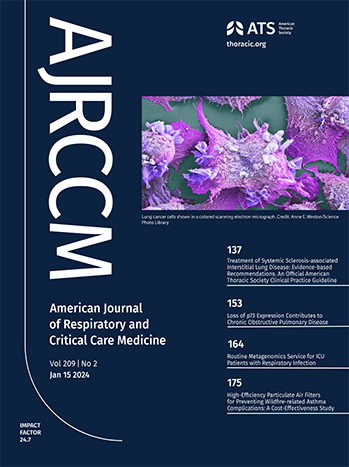The Effectiveness of Isoniazid Preventive Treatment among Contacts of Multidrug-Resistant Tuberculosis: A Systematic Review and Individual-Participant Meta-Analysis.
IF 19.4
1区 医学
Q1 CRITICAL CARE MEDICINE
American journal of respiratory and critical care medicine
Pub Date : 2025-09-23
DOI:10.1164/rccm.202411-2340oc
引用次数: 0
Abstract
RATIONALE Recent empirical research suggests isoniazid may lead to a risk reduction of incident tuberculosis among close tuberculosis contacts of multi-drug resistant (MDR) tuberculosis. OBJECTIVES To evaluate the association between isoniazid tuberculosis preventive treatment (TPT), compared to no treatment, upon incident tuberculosis in household contacts of MDR tuberculosis cases using a large global consortium of tuberculosis contact tracing studies. METHODS We conducted a systematic review and individual-participant meta-analysis among observational studies of household contact tracing studies. Participants were included if they were exposed to someone with MDR-tuberculosis and were given either 6 months of isoniazid TPT or no TPT. Our primary outcome was incident tuberculosis in contacts exposed to tuberculosis. We derived adjusted hazard ratios (aHRs) using mixed-effects, multivariable survival regression models with study-level random effects. The effectiveness of isoniazid TPT against incident tuberculosis was estimated through propensity score matching. We stratified our results by contact age, background tuberculosis burden, and Mycobacterium tuberculosis infection status. MEASUREMENTS AND MAIN RESULTS We included participant-level data from 6,668 contacts exposed to multidrug-resistant tuberculosis from 17 countries. The effectiveness of isoniazid TPT against incident tuberculosis in contacts of multidrug-resistant tuberculosis was 57% (aHR, 0.43; 95% CI, 0.26-0.71) and did not appreciably change with adjustment for additional potential confounders. The reduction in incident tuberculosis was marginally greater among child (<20 years old) contacts (0.51; 95% CI, 0.28-0.92) compared to adult contacts (0.69; 95% CI, 0.22-2.20). The reduction in incidence was 73% (0.27; 95% CI, 0.11-0.70) in the first year of follow-up; effectiveness dropped to 60% (0.40; 95% CI, 0.15-1.06) from 12-23 months of follow-up and was non-significant after two years (28% effectiveness; 0.72; 95% CI, 0.33-1.54). CONCLUSIONS Among over 6,500 contacts of MDR-tuberculosis, isoniazid TPT was highly effective in preventing incident tuberculosis. The reduction was greatest in high-burden countries and waned after 2 years of follow-up.异烟肼预防治疗在耐多药结核病接触者中的有效性:系统评价和个体参与者荟萃分析。
最近的实证研究表明,异烟肼可能导致多药耐药(MDR)结核病密切接触者发生结核病的风险降低。目的:通过一项大型全球结核病接触者追踪研究,评估异烟肼结核病预防治疗(TPT)与不治疗在耐多药结核病家庭接触者中发生结核病之间的关系。方法对家庭接触者追踪研究的观察性研究进行了系统综述和个体参与者荟萃分析。如果参与者暴露于耐多药结核病患者,并给予6个月的异烟肼TPT或不给予TPT,则纳入其中。我们的主要结局是暴露于结核病的接触者发生结核病。我们使用混合效应、具有研究水平随机效应的多变量生存回归模型导出校正风险比(aHRs)。通过倾向评分匹配估计异烟肼TPT对偶发性结核病的有效性。我们根据接触者年龄、背景结核负担和结核分枝杆菌感染状况对结果进行分层。测量方法和主要结果我们纳入了来自17个国家的6668名耐多药结核病接触者的参与者水平数据。异烟肼TPT对多药耐药结核病接触者偶发结核病的有效性为57% (aHR, 0.43; 95% CI, 0.26-0.71),并且在校正其他潜在混杂因素后没有明显变化。与成人接触者(0.69,95% CI, 0.22-2.20)相比,儿童(<20岁)接触者的结核病发病率降低幅度略大(0.51,95% CI, 0.28-0.92)。在随访的第一年,发病率降低了73% (0.27;95% CI, 0.11-0.70);随访12-23个月,有效率下降到60% (0.40;95% CI, 0.15-1.06),两年后无显著性差异(28%有效率;0.72;95% CI, 0.33-1.54)。结论在6500多例耐多药结核接触者中,异烟肼TPT对预防偶发结核有较好的效果。在高负担国家减少幅度最大,并在随访2年后有所减弱。
本文章由计算机程序翻译,如有差异,请以英文原文为准。
求助全文
约1分钟内获得全文
求助全文
来源期刊
CiteScore
27.30
自引率
4.50%
发文量
1313
审稿时长
3-6 weeks
期刊介绍:
The American Journal of Respiratory and Critical Care Medicine focuses on human biology and disease, as well as animal studies that contribute to the understanding of pathophysiology and treatment of diseases that affect the respiratory system and critically ill patients. Papers that are solely or predominantly based in cell and molecular biology are published in the companion journal, the American Journal of Respiratory Cell and Molecular Biology. The Journal also seeks to publish clinical trials and outstanding review articles on areas of interest in several forms. The State-of-the-Art review is a treatise usually covering a broad field that brings bench research to the bedside. Shorter reviews are published as Critical Care Perspectives or Pulmonary Perspectives. These are generally focused on a more limited area and advance a concerted opinion about care for a specific process. Concise Clinical Reviews provide an evidence-based synthesis of the literature pertaining to topics of fundamental importance to the practice of pulmonary, critical care, and sleep medicine. Images providing advances or unusual contributions to the field are published as Images in Pulmonary, Critical Care, Sleep Medicine and the Sciences.
A recent trend and future direction of the Journal has been to include debates of a topical nature on issues of importance in pulmonary and critical care medicine and to the membership of the American Thoracic Society. Other recent changes have included encompassing works from the field of critical care medicine and the extension of the editorial governing of journal policy to colleagues outside of the United States of America. The focus and direction of the Journal is to establish an international forum for state-of-the-art respiratory and critical care medicine.

 求助内容:
求助内容: 应助结果提醒方式:
应助结果提醒方式:


